The clinical guidelines for the treatment of clients with periodontitis stages I-III published by the European Federation of Periodontology in 2020 suggest providing treatment for periodontitis in a preestablished stepwise approach. After the client is informed of their condition, the first step is directed toward motivation, targeting behavioural changes to achieve adequate oral self-care practices, and controlling local and systemic modifiable factors (e.g., smoking).
The second step is focused on professional interventions to reduce and possibly eliminate subgingival biofilms and calculus. The main component of the second step is mechanical subgingival instrumentation, combined with effective, self-performed plaque control measures, leading to shifts in the subgingival ecology and host responses. This step aims to resolve periodontal inflammation by closure of periodontal pockets (probing pocket depth ≤ 4 mm, absence of bleeding on probing) employing different types of instruments and treatment protocols. The outcomes of the subgingival instrumentation have to be evaluated to guide the clinician in providing additional but focused treatment in the remaining pockets or at sites with residual inflammation.
This article discusses:
- Various instruments used for subgingival instrumentation, including hand and sonic/ultrasonic instruments, air-polishing devices, and lasers.
- Advances in non-surgical periodontal treatment protocols.
- Host response and microbiota changes induced by nonsurgical therapy.
- Client-reported experiences and outcomes.
- Cost-effectiveness of therapy.
Click here to read the full article.



